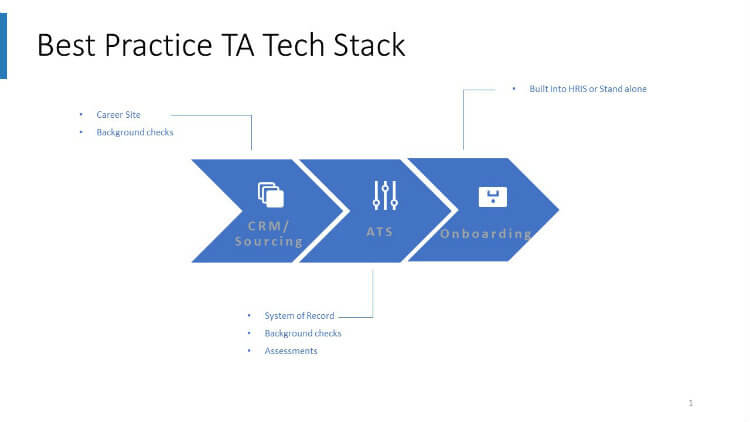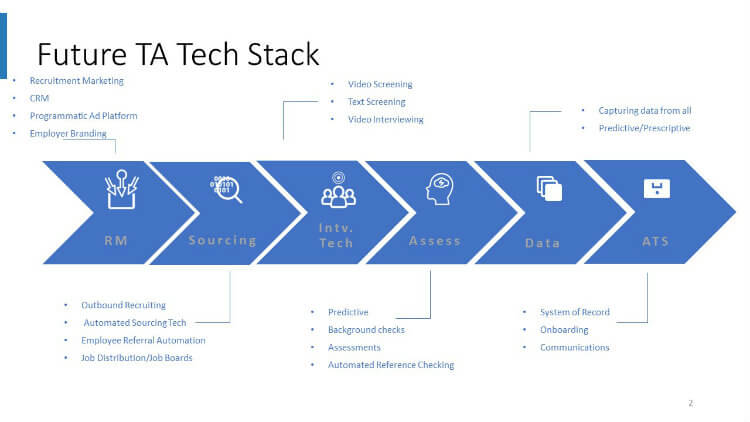The traditional technology configuration for recruiting and hiring at the enterprise level is changing from being solely an applicant tracking setup to one with more analytics, automation and marketing tools, said Tim Sackett, HR thought leader and president of HRU Technical Resources, an engineering and design staffing firm based in Lansing, Mich.
“In five years, what we consider to be an ATS [applicant tracking system] now will no longer exist in talent acquisition,” Sackett told attendees at CareerBuilder’s Empower 2017, a conference for recruiting professionals held by the recruiting software company.
“The ATS is just a database, a system of record for talent acquisition, similar to the HRIS [human resource information system] for HR,” he said. “The reality is that TA [talent acquisition] is moving more toward marketing technologies.”

Today’s Best-Practice TA Tech Stack
Sackett explained that a best-practice TA tech setup currently relies on the ATS as its core piece. From there, employers add a sourcing and candidate relationship management (CRM) component at the top of the stack and an onboarding tool on the other end, either as a part of the ATS, the HRIS or a stand-alone. In addition, the ATS should be integrated with background screening and assessment components.
“This is where you should be today,” he said. “Many aren’t, but that’s OK, as long as you’re working toward it.”
He pointed out that “some ATS vendors will say they offer sourcing, or CRM, but those are for the most part crap. There’s a couple maybe that do it well, but the reality is that for really good CRM right now, you have to bolt it on.” He added that what ATSs are trying to sell are mass e-mail blasts masquerading as CRM. “That’s not CRM. That’s not how you nurture a candidate.”

The Future Best-Practice TA Tech Stack
The future best-practice tech configuration will be front-loaded with a fully functioning CRM that includes a recruitment marketing platform, employer branding technology, a fully optimized careers site and programmatic ad placement. Programmatic advertising helps employers decide how and where to buy ads by targeting specific demographics. Consumer marketing has been using programmatic advertising for over a decade.
“If you have a need for a critical care nurse in Chicago, programmatic ads will keep popping up in front of people who fit that profile based on their online behavior,” Sackett said. “Only 18 percent of organizations are using programmatic for job posting, but in a few years, it will be 90-plus percent. You will have to figure this out.”
Programmatic is less comfortable for HR because the cost varies. “It’s pay-per-applicant, so you don’t know how much it will cost to get 10 applicants, but the reality is that it ends up being 60-75 percent less than what you spend on traditional recruitment marketing,” he said.
Automated sourcing technology, including employee referral automation, should be next in the stack. “Employee referral automation is probably the most underutilized, highest ROI [return on investment] of any TA tech on the market, and still only about 35-40 percent of organizations are even using it,” Sackett said.
“Think about it: What’s your No.1 source of hire?” he asked the audience. “Referrals are usually either first, second or third. What’s your top quality of hire? Employee referrals. If referrals are one of your top sources of hire and the top quality of hire, why aren’t we all in on employee referral automation?”
Screening and interviewing tools using video and text messaging come next. “All recruiters should be texting candidates right now,” Sackett said. “There is some great tech out there that you can bolt on to your ATS that will capture the whole conversation, which is great for when you’re screening through text. There’s also some AI [artificial intelligence] text-screening on the market which can help a recruiter manage several text conversations simultaneously and answer basic FAQs.”
Other segments will contain predictive analytics tools, employee assessments and automated reference checks before funneling into the ATS and onboarding solution.
Owning Your TA Tech Choices
Sackett said that talent acquisition leaders still don’t typically get to pick the technologies they use, but that is changing. “The talent function houses the expertise on TA for the organization. But for the most part, IT still picks the tech. That shouldn’t be happening.”
Talent leaders will have to educate themselves on the changing technology landscape however, before usurping IT’s traditional role. “There are about 27 different verticals of TA tech you could buy,” Sackett said.
Talent acquisition leaders should create a technology road map that will work in tandem with human resources and IT road maps, suggested Nick Mailey, vice president of talent acquisition at financial software company Intuit in San Francisco. “Developing that tech road map is critical,” he said.
“Keeping up with technology is a part of your job in talent acquisition,” said William Tincup, president of RecruitingDaily.com in Dallas-Fort Worth. Tincup explained that TA leaders looking to invest in new technologies should consider whether the tools are predictive, easy to access anywhere with Wi-Fi and on any device—a laptop, smartphone or tablet—and whether they will recommend how to clean data.
Recruiters should look for products that will fit their processes. “Processes are always more important than products,” he said.
Being able to analyze and interpret the data from the various platforms will also be important. “One of the biggest hires we’re seeing now in corporate TA is for business intelligence analysts,” Sackett said. “We have so much data and don’t know how to interpret it.”
This article was first published on SHRM.org
Post Views: 14,396